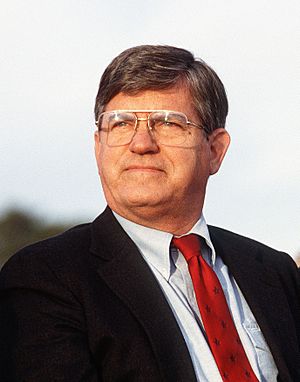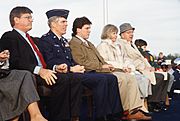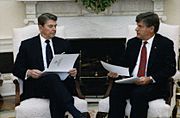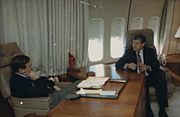James G. Martin facts for kids
Quick facts for kids
James G. Martin
|
|
|---|---|

Martin at Johnson AFB, December 1988
|
|
| 70th Governor of North Carolina | |
| In office January 5, 1985 – January 9, 1993 |
|
| Lieutenant | Robert Jordan Jim Gardner |
| Preceded by | Jim Hunt |
| Succeeded by | Jim Hunt |
| Member of the U.S. House of Representatives from North Carolina's 9th district |
|
| In office January 3, 1973 – January 3, 1985 |
|
| Preceded by | Charles R. Jonas |
| Succeeded by | Alex McMillan |
| Member of the Mecklenburg County Board of Commissioners | |
| In office 1967–1973 |
|
| Personal details | |
| Born |
James Grubbs Martin
December 11, 1935 Savannah, Georgia, U.S. |
| Political party | Republican |
| Spouse | Dorothy Ann McAulay |
| Children | 3 |
| Residences | Charlotte, North Carolina, U.S. |
| Alma mater | Davidson College (BS) Princeton University (PhD) |
| Profession | professor, politician, writer organic chemist |
James Grubbs Martin (born December 11, 1935) is an American chemist and politician. He served as the 70th governor of North Carolina from 1985 to 1993. Before that, he was a U.S. representative for North Carolina for six terms. He is a member of the Republican Party.
Martin was the third Republican to become governor of North Carolina after the Reconstruction period. He was also the only Republican to serve two full terms as the state's governor.
Contents
Early Life and Education
James Grubbs Martin was born on December 11, 1935, in Savannah. He grew up in South Carolina. In 1957, he graduated from Davidson College with a science degree. Soon after, he married Dorothy Ann McAulay. Martin enjoyed playing the tuba.
Academic Career
Martin earned his PhD in chemistry from Princeton University in 1960. His special study was about a type of chemical reaction called the "Diels-Alder reaction." After that, he taught chemistry at Davidson College until 1972. While teaching, he also advised the school's Young Republicans club.
Political Journey
James Martin joined the Republican Party in the early 1960s. He explained that he joined the minority party because he felt the South needed more than one main political party. In 1966, he was elected to the Mecklenburg County Board of Commissioners. He served there for seven years and was the chairman for some of that time.
Serving in the U.S. House of Representatives (1973–1985)
In 1972, Martin was elected to the United States House of Representatives. He represented the 9th Congressional district, which includes Charlotte. He served six terms in Congress. He was part of the Ways and Means Committee, which handles tax laws. In 1983, he received an award from the American Chemical Society for his public service as a chemist.
In 1984, Governor Jim Hunt could not run again because of term limits. Martin ran for governor as a Republican. He won against state attorney general Rufus Edmisten. Martin was helped by Ronald Reagan's big win in the presidential election that year. He also got support from Lieutenant Governor Jimmy Green, who had lost to Edmisten in the Democratic primary.
Governor of North Carolina (1985–1993)
When James Martin ran for governor, he made one big promise. He said that the construction of Interstate 40 from Raleigh to Wilmington, North Carolina would be finished before he left office. This part of I-40 was the last section to be completed across the country. Finishing it would connect the southeastern coast to the rest of the state. Martin kept his promise, and the road was finished during his first term.
Martin was reelected easily in 1988. He defeated Lieutenant Governor Bob Jordan. This made him the only Republican to be elected to two terms as governor of North Carolina.
Later Life
In 1993, after leaving political office, Martin became the chairman of the James Cannon Research Center board. This center is part of Carolinas Medical Center in Charlotte. In 2012, he was asked to lead an investigation into academic problems at the University of North Carolina at Chapel Hill. For the 2016 presidential election, Martin supported John Kasich.
Works
- Revelation through Science (2016)
Legacy
In January 2017, a group called the Pope Center for Higher Education Policy changed its name. It became the James G. Martin Center for Academic Renewal, named after Governor Martin. Governor Martin also serves on the board of directors for this center.
Gallery
-
1988. Martin at Johnson AFB with U.S. Senator Jesse Helms (right)
-
1988. Martin and U.S. President Ronald Reagan
-
1991. Martin and U.S. President George H. W. Bush





